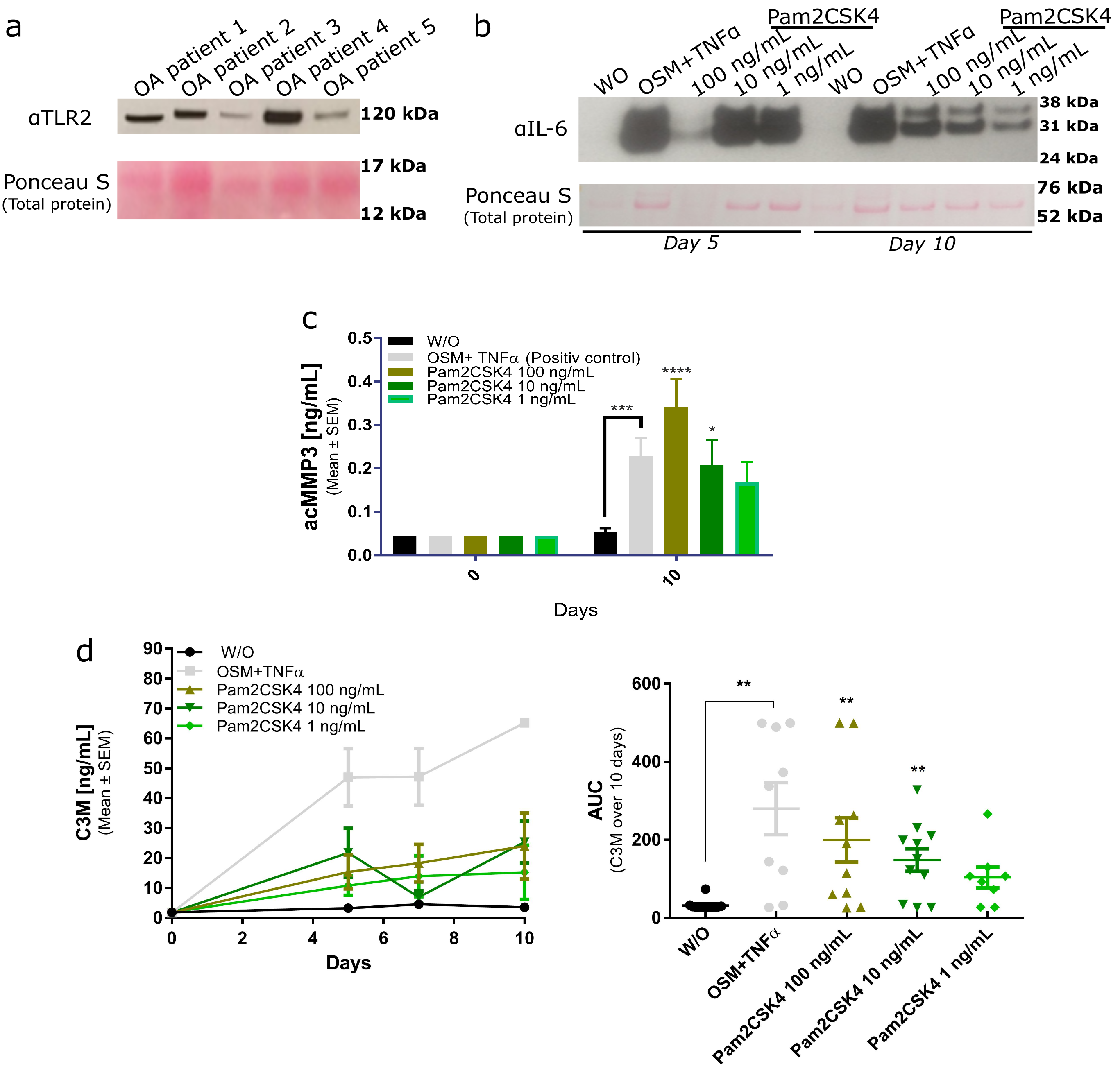Session Information
Session Type: ACR Poster Session B
Session Time: 9:00AM-11:00AM
The innate immune system is important for initiation and development of OA. Increased degradation of the cartilage release fragments into the synovial fluid, which can then bind to innate immune receptors in the synovium. The aim of this study was to investigate the effect of Toll like receptor 2 (TLR2) activation by synthetic agonists and a synthetic aggrecan 32 amino acid fragment (32-mer) on the tissue turnover and IL-6 secretion, in a human synovial membrane explant model.
Methods:
Human synovial membrane biopsies retrieved from OA patients undergoing total knee replacement were lysed and the presence of TLR2 were investigated by western blotting. Human synovial membrane explants (SME) were prepared from the synovial biopsies: Excess fat was removed and the biopsies were cut into explants of 30±5 mg. The SMEs were cultured for 14 days without treatment (WO), OSM [10ng/mL] + TNFα [20ng/mL] (positive control), Pam2CSK4 in three doses (100 ng/mL, 10 ng/mL, or 1 ng/mL), or Pam3CSK4 in three doses (300 ng/mL, 30 ng/mL, or 3 ng/mL). Furthermore, stimulation with a synthetic aggrecan 32-mer (100000 ng/mL, 10000 ng/ml, 1000 ng/ml, 100 ng/ml and 10 ng/ml, respectively) was evaluated. Release of the neo-epitope biomarkers acMMP3 and C3M were measured by ELISA and secretion of IL-6 was evaluated by western blotting at day 5 and 10 in the conditioned media.
Results:
Western blotting confirmed the presence of TLR2 in untreated OA synovial biopsies (Fig. 1a). Activation of the SMEs were assessed by acMMP3, C3M, and IL-6 release. OSM+TNFα significantly increased the release of IL-6 secretion, acMMP3 (P<0.05), and C3M (P<0.01) (Fig. 1). The TLR2 agonists, Pam2CSK4 and Pam3CSK3, significantly increased the release of acMMP3 at day 10 compared to WO (PAM2CSK4: 100 ng/mL P <0.001, 10 ng/mL P=0.016, Pam3CSK4: 30 ng/mL P<0.001) (Fig. 1c). The overall C3M release was significantly increased by Pam2CSK compared to WO (100 ng/mL P=0.007 and 10 ng/mL: P=0.008) (Fig. 1d). Pam3CSK tended to increase the overall C3M and significantly increased C3M release at day 10 compared to WO (100 ng/mL: P=0.035, 10 ng/mL: P=0.008). The western blotting confirmed increased secretion of IL-6 from SMEs stimulated with Pam2CSK4 (Fig. 1b) and Pam3CSK4 compared to WO. Synthetic aggrecan 32-mer did not show any significant increase of C3M release from the synovium.
Conclusion:
TLR2 is expressed in synovium of OA patients and their activation by synthetic ligands resulted in increased tissue turnover confirmed by release of activated MMP3, acMMP3, and MMP-mediated degradation of type III collagen, C3M. Additionally, activation of TLR2 lead to an increased secretion of the pro-inflammatory cytokine IL-6. A synthetic peptide of the potential biological ligand of TLR2, the aggrecan 32-mer failed to generate a significant C3M response compared to WO. We hypothesize that it may be different with the glycosylated native aggrecan 32-mer.
To cite this abstract in AMA style:
Sharma N, Kayed A, Kjelgaard-Petersen CF, Christiansen TG, Karsdal M, Thudium CS, Bay-Jensen AC. Activation of Toll-like Receptor 2 in Human Synovium Explants Increase Tissue Turnover and Secretion of Interleukin-6 [abstract]. Arthritis Rheumatol. 2017; 69 (suppl 10). https://acrabstracts.org/abstract/activation-of-toll-like-receptor-2-in-human-synovium-explants-increase-tissue-turnover-and-secretion-of-interleukin-6/. Accessed .« Back to 2017 ACR/ARHP Annual Meeting
ACR Meeting Abstracts - https://acrabstracts.org/abstract/activation-of-toll-like-receptor-2-in-human-synovium-explants-increase-tissue-turnover-and-secretion-of-interleukin-6/

